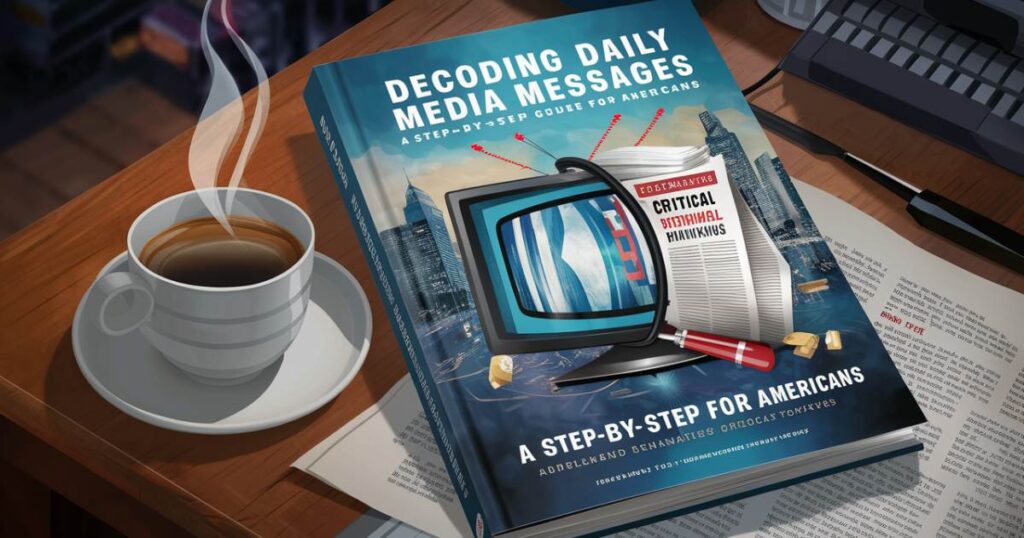In today’s media-saturated world, we’re constantly bombarded with messages vying for our attention. From news updates and reports to social media posts, advertisements, and broadcasts, how can you separate fact from fiction and understand the underlying motives behind these messages? Developing robust media literacy skills is essential for navigating the complex media landscape we face each day.
This comprehensive guide outlines the steps needed to analyze media messages critically, empowering you to become a more informed and conscientious consumer of information.
Understanding the Pervasive Nature of Media
We live in an era where media messages surround us from morning till night. It could be the news anchor on your radio alarm or the podcast you listen to during your morning commute. Throughout the day, you encounter a constant stream of posts, updates, and advertisements on various platforms like social media, websites, and mobile apps.
Even when you step outside, billboards and outdoor displays vie for your attention. By the time you unwind in the evening, you’re likely catching up on the day’s events through news broadcasts or streaming your favorite shows.
This pervasiveness of media in our daily lives underscores the importance of being a critical consumer. Media messages shape our perceptions, opinions, and beliefs, often in subtle ways. Developing the skills to analyze and evaluate these messages is crucial for understanding the world around us and making informed decisions.
Also Read This Post:
BESTADVISE4U.COM NEWS LATEST UPDATES & EXPERT GUIDANC
Identifying Different Types of Media Messages
The first step in media analysis is identifying the different types of messages we encounter. Here are some common examples:
Advertisements
Advertisements are ubiquitous, appearing in various forms, from billboards and TV commercials to sponsored social media posts and online banners. Their primary goal is to persuade you to purchase a product or service. When analyzing advertisements, consider the following:
- Visuals: Are the images eye-catching and designed to grab your attention?
- Catchphrases and slogans: Do they use memorable phrases that stick in your mind?
- Target audience: Who are these ads aimed at, and how do they appeal to that specific demographic?
- Emotional appeals: What emotions (e.g., fear, desire, happiness) are they trying to evoke to influence your decision-making?
News Reports
News reports aim to inform the public about current events, issues, and happenings. When analyzing news reports, pay attention to:
- Source credibility: Is the news source reputable and known for accurate reporting?
- Fact-checking: Are facts clearly stated, and are they supported by credible sources?
- Balanced perspectives: Are multiple viewpoints presented, or is the report skewed toward a particular narrative?
- Context: Why is this news important, and how does it fit into the broader societal or global context?
Social Media Content
Social media platforms are a hub of various types of content, from personal updates and memes to brand promotions and influencer posts. When analyzing social media content, consider:
| Content Type | Origin | Purpose | Engagement |
|---|---|---|---|
| Personal Updates | Individuals | Share life moments | Likes, comments |
| Memes | Creators, Brands | Entertain | Shares, tags |
| Brand Posts | Businesses | Promote products | Follows, purchases |
Critical Questions for Decoding Media Messages
Once you’ve identified the type of media message, it’s essential to ask critical questions to decode its true meaning and intent. Here are some key questions to consider:
Who is the sender, and what is their motivation?
Understanding the source of a message is crucial. Is it an individual, a corporation, a government entity, or a special interest group? What do they stand to gain from disseminating this message? Assessing the sender’s credibility and potential biases is essential for evaluating the message’s reliability.
What is the intended message (explicit and implicit)?
Every media message has an intended purpose, whether it’s to inform, persuade, entertain, or sell something. While the explicit message may be apparent, it’s crucial to look for any underlying or implicit meanings, agendas, or biases.
What techniques are used to capture attention and influence perception?
Media creators employ various techniques to make their messages more compelling and persuasive. These can include:
- Language patterns and keyword usage
- Visuals or sounds that evoke specific emotions or grab attention
- Appeals to logic or emotion
- Storytelling or narrative techniques
By identifying these techniques, you can better understand how the message is trying to influence your thoughts, feelings, and actions.
Recognizing Bias and Perspective
Every media message carries a certain bias or perspective, whether intentional or unconscious. As consumers, it’s essential to recognize these biases and understand how they shape the information we receive.
Identifying subjectivity and one-sided narratives
Media sources may present information in a way that favors a particular viewpoint or agenda. Look for signs of partiality, such as:
- Omitting crucial facts or context
- Using loaded language or exaggerated claims
- Relying heavily on anecdotal evidence or subjective experiences
Comparing multiple sources for objectivity
To gain a more balanced understanding of an issue or topic, compare how different media outlets cover the same story. Note any variations in the facts presented, the language used, or the overall tone and narrative. Consulting multiple sources can help you identify potential biases and form a more objective perspective.
Analyzing emotional triggers and language patterns
Media creators often use language and imagery to evoke specific emotional responses from their audience. Be aware of emotional triggers, such as fear-mongering, appealing to patriotism or nostalgia, or using guilt tactics. Analyze the language patterns and word choices used to convey the message, as these can reveal underlying biases or manipulation tactics.
“The conscious and intelligent manipulation of the organized habits and opinions of the masses is an important element in democratic society.” – Edward Bernays, pioneer in the field of public relations and propaganda
Analyzing Visuals and Language
Visual elements and language play a crucial role in how we perceive and interpret media messages. Developing the skills to analyze these components critically is essential for understanding the full context and impact of the message.
Interpreting images
Images can convey complex ideas and evoke powerful emotions instantly. When analyzing visuals, consider:
- Subject: What is the main focus or subject of the image?
- Composition and framing: What is included or excluded from the frame, and how does this influence the viewer’s perception?
- Color and lighting: How do the color schemes and lighting choices set the mood or highlight specific elements?
- Symbols and metadata: Are there any symbols, timestamps, or other metadata that provide additional context or meaning?
Deciphering word choice and tone
The language used in media messages is carefully crafted to influence how we receive and interpret the information. Pay attention to:
- Keywords and phrases: These often carry the core message or serve as emotional triggers.
- Connotations: Words can have positive, neutral, or negative connotations that shape our emotional responses.
- Language style: Is the language formal, casual, technical, or colloquial, and how does this align with the intended audience?
- Tone: Is the overall tone friendly, aggressive, informative, or persuasive, and how does this impact the message’s reception?
Remember, the context in which words and visuals are used can significantly alter their meaning and impact.
Fact-checking and Verification
In the age of misinformation and “fake news,” it’s crucial to develop the skills to fact-check and verify the information we consume from various media sources.
Cross-referencing information from various sources
Never rely on a single source for information, especially on critical or controversial topics. Cross-reference the information across multiple reputable and independent sources to corroborate the facts. If a story is true and significant, it’s likely that many outlets will be reporting on it.
Using fact-checking tools
The internet provides powerful tools to help verify the authenticity of media messages. Some reputable fact-checking resources include:
- Snopes: A well-known fact-checking website that investigates and debunks urban legends, internet rumors, and misinformation.
- FactCheck.org: A non-partisan, nonprofit project dedicated to fact-checking statements made by politicians, pundits, and other public figures.
- Google Reverse Image Search: This tool allows you to upload an image and search for its origins, helping to identify manipulated or misrepresented visuals.
The importance of primary sources and expert insights
When researching a topic, prioritize primary sources (e.g., scientific studies, government reports, official statements) over second-hand accounts or interpretations. Additionally, seek out expert insights and analyses from credible authorities in the relevant field.
Steps to Effectively Decode Media Messages

Now that we’ve covered the essential components of media analysis, let’s outline the systematic steps you can take to effectively decode the media messages you encounter daily:
- Summarize the core message and intent Begin by identifying the central message or argument being presented. What is the content essentially telling you? Is it a news item, an advertisement, a social media post, or a piece of entertainment? Summarize the main points or recurring themes in a concise manner, clarifying the intended purpose – whether to inform, persuade, entertain, or sell something.
- Evaluate the evidence and logic behind claims After summarizing the message, dive deeper into the supporting evidence and reasoning presented. Accuracy and reliability are crucial at this stage. Check the credibility of the sources cited and verify any facts or statistics with additional reputable sources if possible. Examine the logic and reasoning used to support the central arguments, and be aware of any fallacies, biases, or emotional appeals that may skew the information.
- Draw informed conclusions based on analysis With the information gathered and analyzed, you can now synthesize your findings to form a well-rounded understanding of the media message. Combine the evidence, messaging, and your analysis to develop a nuanced perspective on the topic. Assess the potential impact of the message on the intended audience and decide where you stand regarding the presented information.
By following these steps, you can peel back the layers of media messages we encounter daily, leading to a more enlightened and discerning interaction with the media-saturated world around us.
The Implications of Misinformation
Deep-diving into the implications of misinformation highlights the urgency of media literacy in our society. Each day, we sift through a dense forest of media messages, each carrying the potential seeds of untruth. Identifying these seeds is not child’s play but critically defines the texture of our reality.
Effects on public perception and trust Media shapes minds, but misinformation can twist that shape, leading viewers astray. Establishing robust discernment practices is critical to unmuddling the true from the false and maintaining a healthy public perception. Failure to do so can lead to:
- Heightened skepticism toward even credible news sources and institutions
- A deficit of trust in authoritative figures and expert opinions
- The spread of conspiracy theories and unfounded claims
Societal consequences Misinformation, when left unchecked, can erode the foundations of society. It brews confusion, fuels conflict, and can occasionally ignite chaos. Some potential consequences include:
| Impact | Result |
| Trust Deficit | Institutional distrust spikes, undermining social cohesion |
| Polarization | Communities become divided along ideological lines |
| Health Risks | Public health advice and guidelines are ignored |
| Erosion of Democracy | Misinformed electorate makes decisions based on falsehoods |
Arming our society against misinformation ensures resilience and paves the path toward prosperity, peace, and a well-informed citizenry.
“A lie can travel halfway around the world while the truth is putting on its shoes.” – Mark Twain
Enhancing Media Literacy Education
Every day, our senses are bombarded with messages from various media sources. Media literacy education arms us with critical thinking skills, which help us understand and analyze these messages effectively. It’s essential in today’s digital world driven by information and communication.
Let’s explore how we can boost our media literacy through effective teaching strategies and the vital role of educational institutions. Teaching Strategies Media literacy requires active learning and engagement. Teachers can employ several strategies to enhance it in classrooms:
- Discussion Circles: Engage students in conversations about media messages they encounter in their daily lives, fostering critical thinking and diverse perspectives.
- Case Studies: Analyze real-world media examples to identify biases, perspectives, and persuasive techniques employed.
- Role-playing: Encourage empathy and understanding of different sides of a media story by having students take on various roles.
- Project-Based Learning: Have students create their own media campaigns as a class exercise, providing hands-on experience in understanding the creation and impact of media messages.
Role of Educational Institutions Schools and colleges play a direct and influential role in shaping media literacy among students. They have a significant responsibility in preparing learners:
| Education Level | Media Literacy Action |
|---|---|
| Primary | Introduce the basics of responsible media consumption and online safety. |
| Secondary | Enhance critical analysis skills for various media messages and explore media creation. |
| Tertiary | Focus on research-driven understanding of media influence, ethics, and societal impact. |
Educational institutions must integrate media literacy across subjects, revealing its relevance to all aspects of life. They should also support teachers with resources, training, and fostering environments where media literacy thrives through practice, discussion, and ongoing learning.
Becoming a Conscientious Media Consumer

Becoming a savvy and responsible media consumer is crucial in a world blanketed with media messages. Media surrounds us, from the buzz of social media notifications to the hum of TV commercials. How we analyze and interpret these messages shapes our views, decisions, and actions. Here’s how you can engage in this journey to become a more conscientious media consumer:
Adopting a mindset of skepticism Question everything you encounter in the media landscape. Don’t accept messages at face value; instead, adopt a mindset of healthy skepticism. Check the credibility of sources, look for evidence that supports claims, and ask critical questions like who created the message and why.
Promoting ethical media practices and transparency Advocate for integrity and ethics in media production and consumption. Support outlets, creators, and platforms that prioritize transparency, fact-checking, and responsible reporting. Highlight and share good practices, while discouraging the spread of misinformation by not engaging with or sharing unverified content.
Taking action against media manipulation Recognize and counteract media manipulation by taking specific actions to protect your thoughts from external influence. Here are some actionable steps:
- Support Regulation: Laws can help control media fairness and transparency. Advocate for initiatives that promote fact-checking, transparent labeling of sponsored content, and algorithms that limit the spread of fake news.
- Empower Communities: Communities need the skills to dissect media messages critically. Support workshops, discussion forums, and school programs that equip individuals with the analytical tools to identify manipulation tactics and make informed decisions.
By becoming a conscientious media consumer, you contribute to a well-informed society that values truth, accountability, and ethical practices in the media landscape.
Conclusion
Navigating the sea of daily media messages can be manageable with the right skills and mindset. Mastering the outlined steps empowers you to discern fact from fiction, understand underlying motives, and critically analyze the information you consume. Remain vigilant, question content for authenticity and bias, and engage with media messages as an informed and discerning consumer.
Developing robust media literacy is not just an individual responsibility but a societal imperative. By fostering these skills through education, regulation, and community empowerment, we can create a more informed, resilient, and truth-seeking society.
Remember, the ability to decode media messages shapes our understanding of the world. Embrace this power, and use it wisely to navigate the ever-evolving media landscape with confidence and clarity.

Charlis, with 6 years of experience, is a seasoned writer at Techno Krafter. He crafts engaging content with a knack for simplifying complex concepts, enriching readers’ understanding across various tech domains.







